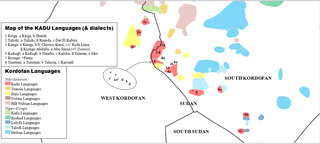Related Research Articles

The West Atlantic languages of West Africa are a major subgroup of the Niger–Congo languages.
The Adamawa languages are a putative family of 80–90 languages scattered across the Adamawa Plateau in central Africa, in Nigeria, Cameroon, Central African Republic, and Chad, spoken altogether by only one and a half million people. Joseph Greenberg classified them as one branch of the Adamawa–Ubangi family of Niger–Congo languages. They are among the least studied languages in Africa, and include many endangered languages; by far the largest is Mumuye, with 400,000 speakers. A couple of unclassified languages—notably Laal and Jalaa—are found along the fringes of the Adamawa area.

The Atlantic–Congo languages are the largest demonstrated family of languages in Africa. They have characteristic noun class systems and form the core of the Niger–Congo family hypothesis. They comprise all of Niger–Congo apart from Mande, Dogon, Ijoid, Siamou, Kru, the Katla and Rashad languages, and perhaps some or all of the Ubangian languages. Mukarovsky's West-Nigritic corresponded roughly to modern Atlantic–Congo.
Ijoid is a proposed but undemonstrated group of languages linking the Ijaw languages (Ịjọ) with the endangered Defaka language. The similarities, however, may be due to Ijaw influence on Defaka.

The Kadu languages, also known as Kadugli–Krongo or Tumtum, are a small language family of the Kordofanian geographic grouping, once included in Niger–Congo. However, since Thilo Schadeberg (1981), Kadu is widely seen as Nilo-Saharan. Evidence for a Niger-Congo affiliation is rejected, and a Nilo-Saharan relationship is controversial. A conservative classification would treat the Kadu languages as an independent family.
Day is an Adamawa language of southern Chad, spoken by 50,000 or so people southeast of Sarh. Ethnologue reports that its dialects are mutually intelligible, but Blench (2004) lists Ndanga, Njira, Yani, Takawa as apparently separate languages.
The Savannas languages, also known as Gur–Adamawa or Adamawa–Gur, is a branch of the Niger–Congo languages that includes Greenberg's Gur and Adamawa–Ubangui families.

The Rashad languages form a small language family in the Nuba Hills of Sudan. They are named after Rashad District of South Kordofan.
The Ubangian languages form a diverse linkage of some seventy languages centered on the Central African Republic. They are the predominant languages of the CAR, spoken by 2–3 million people, and include the national language, Sango. They are also spoken in Cameroon, Chad, the DR Congo, and South Sudan.
The Bambukica.k.a.Trans-Benue or Yungur–Jen languages form a proposed branch of the provisional Savanna languages, a reduced form of the Waja–Jen branch of the old Adamawa languages family. They are spoken in north eastern Nigeria. Their unity is not accepted by Güldemann (2018).
Longuda (Nʋngʋra) is a Niger–Congo language of Nigeria. Joseph Greenberg counted it as a distinct branch, G10, of his Adamawa family. Boyd (1989) assigned it a branch within Waja–Jen. When Blench (2008) broke up Adamawa, Longuda was made a branch of the Bambukic languages.

The Talodi–Heiban languages are a proposed branch of the hypothetical Niger–Congo family, spoken in the Nuba Mountains of Sudan. The Talodi and Heiban languages are thought to be distantly related by Dimmendaal, though Glottolog 4.4 does not accept the unity of Talodi–Heiban pending further evidence.
The Tula–Waja, or Tula–Wiyaa languages are a branch of the provisional Savanna languages, closest to Kam (Nyingwom), spoken in northeastern Nigeria. They are spoken primarily in southeastern Gombe State and other neighbouring states.
The Mumuye–Yendang languages are a proposed group of Savanna languages spoken in eastern Nigeria. They were labeled "G5" in Joseph Greenberg's Adamawa language-family proposal.
The Duru languages are a group of Savanna languages spoken in northern Cameroon and eastern Nigeria. They were labeled "G4" in Joseph Greenberg's Adamawa language-family proposal.

The Jukunoid languages are a branch of the Benue-Congo languages spoken by the Jukun and related peoples of Nigeria and Cameroon. They are distributed mostly throughout Taraba State, Nigeria and surrounding regions.
Siamou, also known as Sɛmɛ (Seme), is a language spoken mainly in Burkina Faso. It is unclassified within the proposed Niger–Congo language family and could likely be a language isolate
The Wara–Natyoro or Samu languages are a small group of minor languages of Burkina Faso: Samwe, Paleni and Natyoro, which are notably similar but not mutually intelligible. They were once classified as part of an expanded Gur (Voltaic) family, and are part of Blench's Savannas proposal. Güldemann (2018) tentatively classifies them within the Gur languages.
Lafofa, also Tegem–Amira, is a dialect cluster spoken in the southern Nuba Mountains in the south of Sudan. Blench (2010) considers the Tegem and Amira varieties to be distinct languages; as Lafofa is poorly attested, there may be others.
The Bikwin–Jen or simply the Jen languages form a branch of the Adamawa family. They are spoken in and around Karim Lamido LGA in Taraba State, and in other nearby states of eastern Nigeria.
References
- ↑ Güldemann, Tom (2018). "Historical linguistics and genealogical language classification in Africa". In Güldemann, Tom (ed.). The Languages and Linguistics of Africa. The World of Linguistics series. 11. Berlin: De Gruyter Mouton. pp. 58–444. doi:10.1515/9783110421668-002. ISBN 978-3-11-042606-9.
- ↑ Blench, Roger (2019). An Atlas of Nigerian Languages (4th ed.). Cambridge: Kay Williamson Educational Foundation.